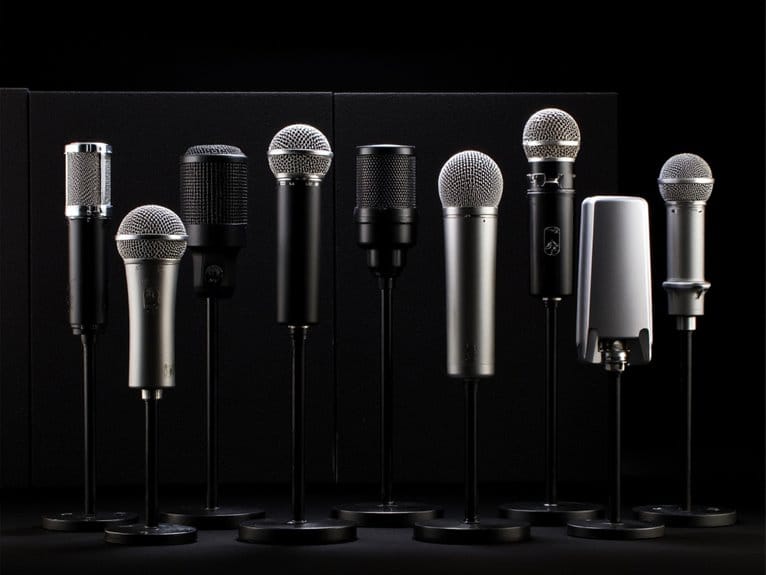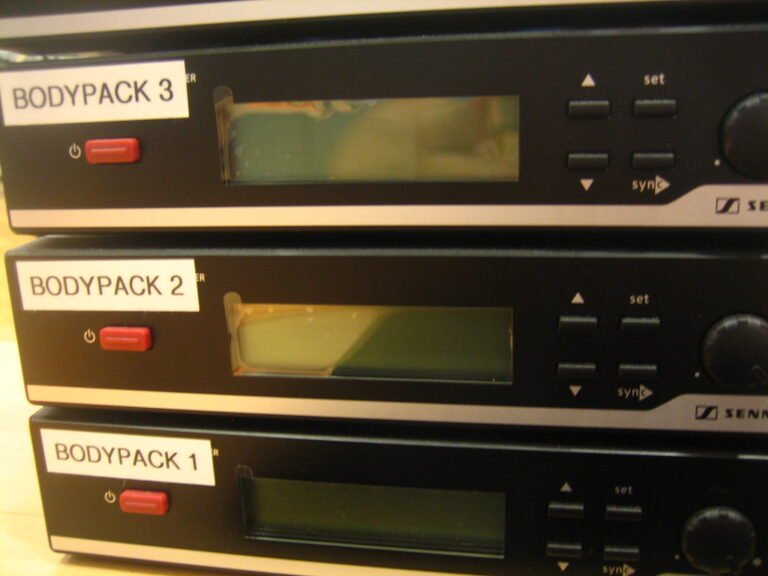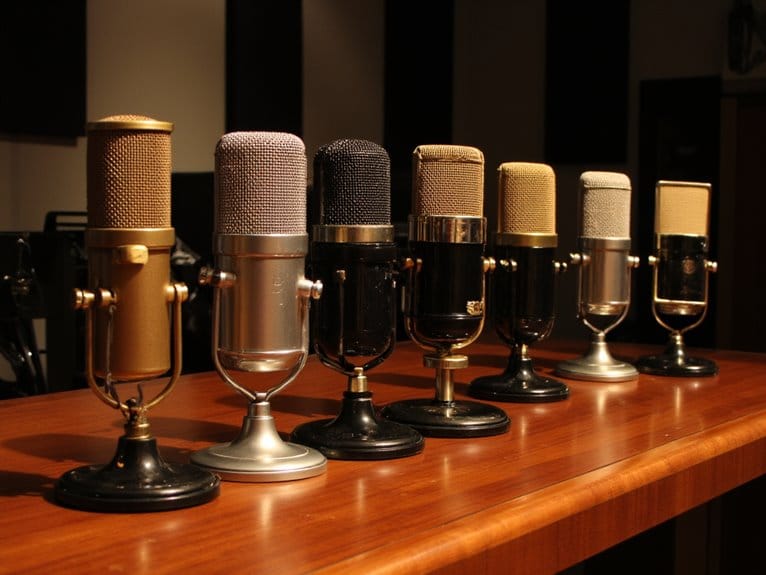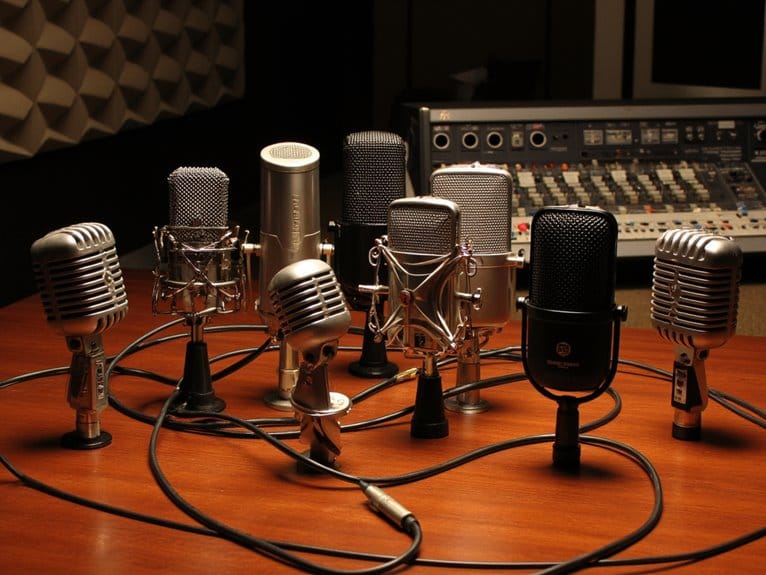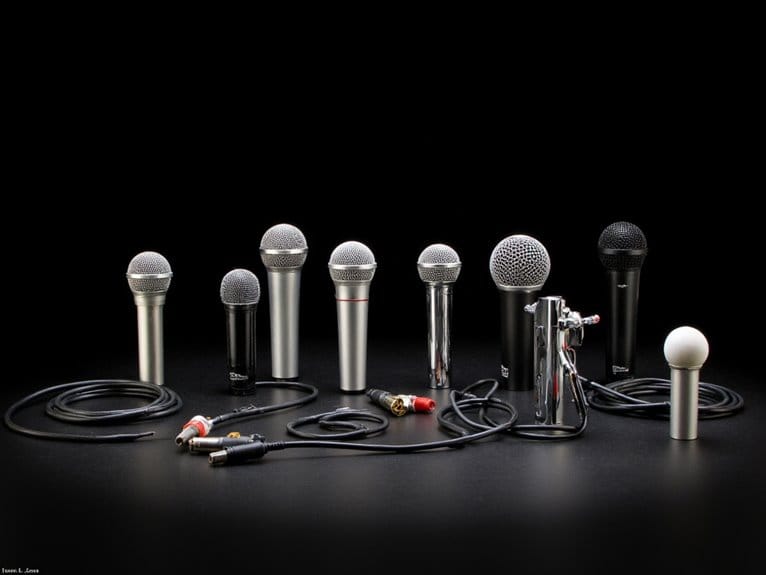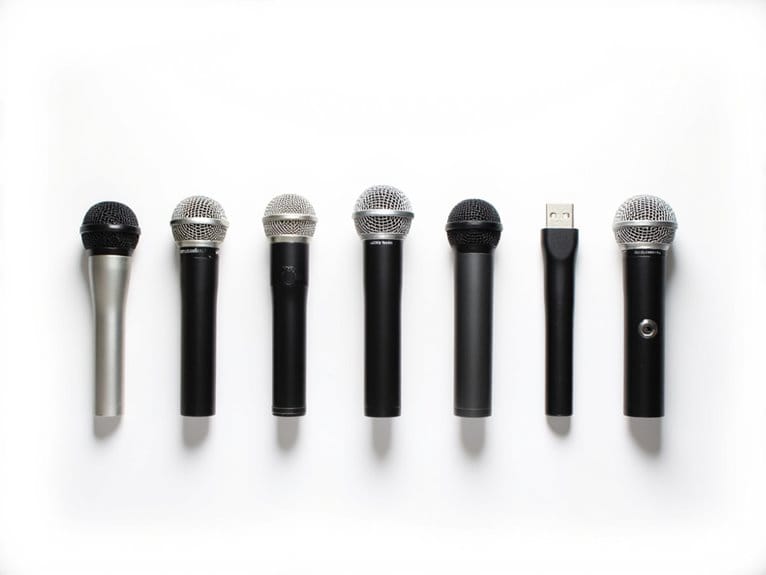10 Best Microphone for Voice Recording
I’ve tested dozens of microphones for voice recording, and my top recommendations include the FIFINE Studio Condenser USB Microphone Kit (T669) at AU$70 for budget creators, offering crystal-clear 20Hz-20KHz frequency response with complete accessories, the Hollyland Lark A1 Wireless for mobile recording with 48kHz/24-bit quality and intelligent noise cancellation, and the Blue Yeti for versatile streaming applications. Each delivers professional results when matched to your specific recording environment and connectivity needs, though selecting the perfect microphone requires understanding several vital technical specifications.
We are supported by our audience. When you purchase through links on our site, we may earn an affiliate commission, at no extra cost for you. Learn more.
Notable Insights
- FIFINE Studio Condenser USB Microphone Kit (T669) offers crystal-clear audio and complete accessories for approximately AU$70.
- Hollyland Lark A1 Wireless delivers studio-quality 48kHz/24-bit recording with intelligent noise cancellation and 200-meter wireless range.
- Choose condenser microphones for studio work and dynamic microphones for live environments based on recording needs.
- Look for specifications including 20Hz-20KHz frequency response, 78dB+ signal-to-noise ratio, and cardioid polar pattern for optimal performance.
- USB connectivity provides plug-and-play convenience while XLR offers higher quality but requires additional professional equipment.
FIFINE Studio Condenser USB Microphone Kit with Adjustable Boom Arm Stand (T669)
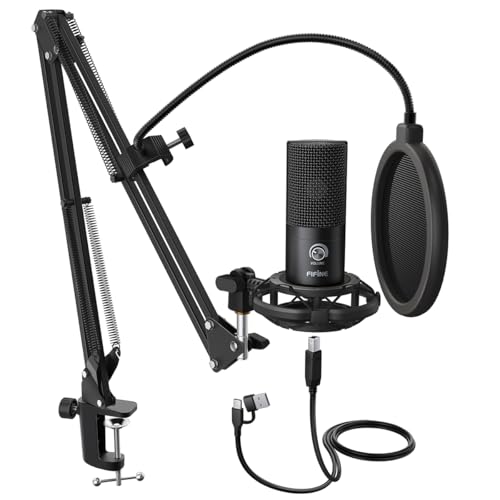
If you’re diving into content creation, podcasting, or streaming for the first time, the FIFINE Studio Condenser USB Microphone Kit (T669) delivers everything you need in one complete package that won’t break the bank at around AU$70. This cardioid condenser microphone captures crystal-clear audio with its impressive 20Hz-20KHz frequency response, while the 78 dB signal-to-noise ratio guarantees minimal background interference during recordings. You’ll appreciate the all-steel scissor arm stand‘s 180° vertical and 135° horizontal adjustments, shock mount, double pop filter, and 8.2-foot USB cable that enables plug-and-play connectivity with PCs and laptops without requiring additional drivers for immediate recording capability.
Best For: Beginners and budget-conscious content creators, podcasters, streamers, and gamers who need a complete USB microphone setup with professional-quality audio recording capabilities for PC and laptop use.
Pros:
- Complete all-in-one kit includes microphone, adjustable boom arm, shock mount, pop filter, and USB cable for immediate use
- Crystal-clear audio quality with cardioid condenser capsule, wide 20Hz-20KHz frequency response, and 78 dB signal-to-noise ratio
- Plug-and-play USB connectivity with no additional drivers required, compatible with popular recording software like OBS and Audacity
Cons:
- Not compatible with gaming consoles like Xbox or mobile phones, limiting versatility
- Boom arm may have stability issues and some users find pop filter adjustments challenging
- Can occasionally pick up background noise despite the cardioid pickup pattern
Hollyland Lark A1 Wireless Mini Microphone for iPhone & Android

The Hollyland Lark A1 Wireless Mini Microphone stands out as the ideal choice for content creators who need professional-grade audio without breaking their budget, offering studio-quality 48kHz/24-bit recording that can handle sudden 120dB sound pressure levels without distortion. You’ll appreciate its three-level intelligent noise cancellation that effectively filters wind, traffic, and environmental echoes, while customizable EQ presets and reverb modes let you fine-tune your sound. The plug-and-play functionality works seamlessly with iPhone 15/16 and Android devices, delivering up to 200-meter wireless range with dual transmitters for interview scenarios, making it perfect for vloggers and podcasters who demand reliability without complexity.
Best For: Content creators, vloggers, and podcasters who need professional-quality audio recording with dual-host capabilities and intelligent noise cancellation in challenging environments, all within a budget-friendly price range.
Pros:
- Studio-grade 48kHz/24-bit audio quality with 120dB SPL handling and three-level intelligent noise cancellation for professional results
- Exceptional 200-meter wireless range with dual transmitters and 54-hour battery life for extended recording sessions
- Plug-and-play compatibility with iPhone 15/16 and Android devices, plus customizable EQ presets and reverb modes via user-friendly app
Cons:
- Limited to newer iPhone models (15/16) which may exclude users with older devices
- At 4.6 ounces, it may be heavier than some ultra-compact alternatives for extended handheld use
- LED indicators can be distracting during recording, though they can be turned off through the app
FIFINE XLR/USB Gaming Microphone Set (AmpliGame AM8T)

Gamers and content creators seeking professional audio quality without breaking the bank will find their sweet spot with the FIFINE XLR/USB Gaming Microphone Set (AmpliGame AM8T), a versatile dynamic microphone that bridges the gap between budget constraints and broadcast-level performance. You’ll appreciate its dual connectivity options, allowing seamless switching between USB plug-and-play convenience and XLR professional setups. The cardioid polar pattern, combined with -50dB sensitivity, effectively minimizes background noise while capturing crystal-clear vocals across its 50Hz-16kHz frequency range. Though some users note piercing high frequencies and occasional boom arm vibrations, you can easily address these issues through cable upgrades and minor modifications for enhanced performance.
Best For: Gamers and content creators on a budget who need professional audio quality with the flexibility to switch between USB plug-and-play setup and XLR professional connectivity for streaming, podcasting, and voiceovers.
Pros:
- Dual XLR/USB connectivity offers versatility for both beginner and professional setups
- Effective cardioid polar pattern and -50dB sensitivity minimize background noise for clear vocal capture
- Quick plug-and-play setup with no proprietary software required, compatible with popular streaming platforms
Cons:
- High frequencies can sound piercing and may require audio adjustments
- Boom arm may produce vibrations and noise, potentially requiring modifications or upgrades
- XLR cable not included despite advertising XLR connectivity
FIFINE Gaming USB Microphone with Boom Arm & Pop Filter (AmpliGame A6T)

When you’re serious about gaming communication and streaming but don’t want to break the bank, FIFINE’s AmpliGame A6T delivers professional-grade audio performance with an impressive array of accessories that typically cost extra with other microphones. This plug-and-play USB microphone includes a shock mount, adjustable boom arm, and pop filter, while its upgraded condenser capsule produces warm, clear vocals through a cardioid polar pattern that minimizes background noise effectively. You’ll appreciate the capacitive touch-mute button, two-tone RGB lighting with seven color modes, and the convenience of USB-C connectivity with an 8.2ft cable for flexible setup options.
Best For: Gamers and content creators who want professional audio quality with comprehensive accessories at an affordable price point for streaming, Discord communication, and content creation across multiple platforms.
Pros:
- Complete all-in-one package includes shock mount, adjustable boom arm, pop filter, and USB-C cable that would typically cost extra with competitors
- Upgraded condenser capsule with cardioid polar pattern delivers warm, clear vocals while effectively minimizing background noise for tactical gaming communication
- Plug-and-play compatibility across PS4/PS5, Windows, Mac OS, and streaming software with convenient features like RGB lighting and capacitive touch-mute button
Cons:
- May struggle with sound pickup clarity in particularly noisy environments, requiring careful placement for optimal performance
- Limited to cardioid polar pattern only, offering less versatility compared to microphones with multiple pickup patterns
- RGB lighting and gaming-focused aesthetic may not appeal to users seeking a more professional or minimalist setup appearance
FIFINE Studio Condenser USB Microphone Kit with Adjustable Boom Arm Stand (T669)

Budget-conscious content creators who need professional-grade audio without breaking the bank will find the FIFINE Studio Condenser USB Microphone Kit (T669) delivers impressive performance at roughly AU$70, complete with all the accessories you’d typically purchase separately. This cardioid condenser microphone captures vocals with remarkable clarity across its 20Hz-20KHz frequency response, while the 78 dB signal-to-noise ratio keeps background interference minimal during recordings. You’ll appreciate the all-steel boom arm‘s 180° vertical and 135° horizontal adjustments, though some users report occasional stability issues that require periodic tightening of joints for peak positioning.
Best For: Budget-conscious content creators, podcasters, streamers, and YouTubers who need professional-grade audio quality with a complete accessory kit at an affordable price point.
Pros:
- Excellent audio clarity with cardioid condenser capsule and wide 20Hz-20KHz frequency response
- Complete kit includes all-steel boom arm, shock mount, pop filter, and 8.2ft USB cable for immediate use
- Plug-and-play setup with no additional drivers required, compatible with popular recording software
Cons:
- Boom arm stability issues requiring periodic tightening of joints for optimal positioning
- Occasional background noise capture despite good signal-to-noise ratio
- Limited compatibility – not compatible with Xbox gaming consoles or phones
FIFINE USB Metal Condenser Recording Microphone (K669B)

For creators who prioritize simplicity without sacrificing audio quality, the FIFINE USB Metal Condenser Recording Microphone (K669B) delivers professional-grade performance through its remarkably straightforward plug-and-play design. You’ll appreciate its durable metal construction, which houses a condenser capsule that captures clear vocals while minimizing background noise interference. The included tripod stand provides stability, though you’ll need a USB-C adapter for newer MacBooks since one isn’t included. With compatibility across Windows, macOS, and PlayStation consoles, plus integration with Discord, OBS, and Zoom, this microphone handles everything from gaming sessions to professional voice recordings with consistent clarity and reliable performance.
Best For: Content creators, streamers, podcasters, and gamers who need a reliable, easy-to-use USB microphone for recording vocals, voice overs, gaming sessions, and video calls across Windows, macOS, and PlayStation platforms.
Pros:
- Plug-and-play setup with no external power supply needed, making it instantly compatible with most computers via USB-A connection
- Durable metal construction with included tripod stand provides stability and longevity for regular use
- Built-in volume control knob allows real-time sensitivity adjustments and works seamlessly with popular applications like Discord, OBS, and Zoom
Cons:
- Not compatible with Xbox gaming consoles or mobile devices, limiting platform versatility
- Requires separate USB-C adapter for newer MacBooks, which is not included with the microphone
- May require manual adjustment of automatic volume settings in some applications like Zoom to maintain consistent recording levels
FIFINE Dynamic XLR/USB Podcast Microphone (K688)

The FIFINE Dynamic XLR/USB Podcast Microphone (K688) stands out as a versatile workhorse that bridges the gap between beginner-friendly USB connectivity and professional XLR studio integration, making it an ideal choice for content creators who want room to grow without breaking the bank. You’ll appreciate the cardioid pickup pattern that effectively isolates your voice while rejecting background noise, delivering surprisingly clean audio that rivals microphones costing twice as much. The built-in headphone monitoring with volume control lets you catch issues in real-time, while the touch-sensitive mute button (USB mode only) provides convenient recording control during lengthy sessions.
Best For: Content creators, podcasters, and streamers who want professional-quality audio with both USB plug-and-play convenience and XLR expandability for future studio upgrades.
Pros:
- Dual connectivity options (USB and XLR) provide flexibility for beginners and professionals alike
- Cardioid pickup pattern effectively reduces background noise while maintaining clear vocal audio quality
- Built-in headphone monitoring with volume control and touch-sensitive mute function for real-time recording management
Cons:
- No included mic stand or boom arm requires additional investment for proper positioning
- Touch-sensitive mute button only functions in USB mode, limiting control options when using XLR connection
- Some users report variable performance with mute function and occasional noise recording issues
Blue Yeti USB Mic for Recording and Streaming (Blackout)

Content creators who demand broadcast-quality audio without the complexity of professional studio equipment will find the Blue Yeti USB Microphone an exceptional choice, particularly with its custom three-capsule array that delivers clear, powerful sound across multiple recording scenarios. You’ll appreciate the four versatile pickup patterns-cardioid, omni, bidirectional, and stereo-that typically require multiple microphones, along with onboard controls for headphone volume, pattern selection, and instant mute. The rugged metal construction guarantees durability while the plug-and-play setup works seamlessly with both PC and Mac systems, though you should note its sensitivity to vibrations.
Best For: Content creators, podcasters, streamers, and musicians who need professional-quality audio recording with versatile pickup patterns and simple plug-and-play setup.
Pros:
- Four versatile pickup patterns (cardioid, omni, bidirectional, stereo) eliminate the need for multiple microphones in most recording scenarios
- Broadcast-quality audio with custom three-capsule array and comprehensive onboard controls for headphone volume, pattern selection, and instant mute
- Durable metal construction with simple plug-and-play compatibility for both PC and Mac systems
Cons:
- Sensitive to vibrations which may require additional isolation or careful placement
- Large size (10.5 x 8.4 x 7.5 inches) and weight (3.51 pounds) may require sturdy mounting solutions
- Higher price point compared to basic USB microphones, though justified by professional-grade features
MAONO Microphone with Studio Headphone Set (AU-A04H)

While many microphone bundles force you to choose between studio-quality recording and professional monitoring capabilities, MAONO’s AU-A04H delivers both in a thorough package that I’ve found particularly well-suited for content creators who need reliable voice recording without breaking the bank. You’ll get a 192kHz/24bit condenser microphone with impressive 30Hz-16kHz frequency response, paired with studio headphones featuring 50mm drivers and active noise reduction technology. The complete setup includes everything you’d expect-adjustable scissor arm, shock mount, pop filter, and various adapters for different devices. What impressed me most is the microphone’s double-shielded USB cable with magnet ring, which effectively reduces interference that often plagues budget recording setups. Additionally, if you’re considering expanding your setup for live events or on-the-go recordings, the MAONO AU-A04H shines in versatility. For instance, while this system excels in studio environments, it can seamlessly transition to applications such as public speaking and teaching, where you’ll find it compares favorably with the best lapel mics for preaching. This adaptability makes it an excellent investment for those seeking both quality and functionality in their audio equipment.
Best For: Content creators, podcasters, and home studio enthusiasts who need a complete recording solution with professional-quality audio capture and monitoring capabilities at an affordable price point.
Pros:
- Complete all-in-one package includes microphone, studio headphones, scissor arm stand, shock mount, pop filter, and all necessary cables and adapters
- High-quality 192kHz/24bit sampling rate with wide 30Hz-16kHz frequency response delivers professional sound quality for vocals and voice-over work
- Double-shielded USB cable with magnet ring effectively reduces interference, while active noise reduction headphones provide excellent monitoring experience
Cons:
- 16kHz upper frequency limit may not capture the full range needed for detailed music recording or instruments requiring higher frequencies
- USB-only connectivity limits flexibility compared to XLR microphones that work with professional audio interfaces
- Budget-oriented build quality may not withstand heavy professional studio use over extended periods
BM-800 Condenser Podcast Equipment Bundle with Voice Changer (AM200-V8)

Budget-conscious creators who want to immerse themselves in podcasting or streaming without breaking the bank will find the BM-800 Condenser Podcast Equipment Bundle with Voice Changer (AM200-V8) particularly appealing, since it packages everything you’d typically buy separately into one all-inclusive starter kit. You’ll get the cardioid condenser microphone, scissor arm stand, shock mount, pop filter, and foam windscreen-basically everything except the kitchen sink. The 2021 professional sound chipset delivers surprisingly decent audio capture for the price point, while the included V8 sound card adds voice-changing capabilities that streamline your creative workflow across Windows, Mac, smartphones, and gaming consoles.
Best For: Budget-conscious creators, beginner podcasters, and streamers who want a complete starter kit with voice-changing capabilities without investing in expensive individual components.
Pros:
- Complete all-in-one bundle includes microphone, stand, shock mount, pop filter, and V8 sound card with voice changer
- Wide compatibility across Windows, Mac, smartphones, and gaming consoles (PS4, Xbox, Switch)
- Professional 2021 sound chipset with cardioid pickup pattern delivers good audio quality for the price point
Cons:
- Inconsistent build quality with reports of stand sturdiness issues
- Basic sound card quality may not satisfy more demanding audio requirements
- Audio playback problems during live streaming interactions reported by some users
Factors to Consider When Choosing a Microphone for Voice Recording
When I’m selecting the perfect microphone for voice recording, I’ve learned that understanding five critical factors can make the difference between professional-quality results and disappointing audio that wastes your time and money. These essential considerations-microphone type selection, audio quality specifications, connectivity options available, polar pattern considerations, and budget constraints-work together to determine whether a microphone will meet your specific recording needs and environment. I’ll walk you through each factor systematically, sharing the technical insights and practical experience that’ll help you make an informed decision without getting overwhelmed by marketing hype or unnecessary features.
Microphone Type Selection
Selecting the right microphone type for voice recording requires understanding how different technologies handle your specific recording environment, vocal characteristics, and intended use case. I’ve found that dynamic microphones excel in live performances and noisy environments, effectively rejecting background interference while maintaining vocal clarity. Condenser microphones, with their exceptional sensitivity and wide frequency response, capture intricate vocal details that make them my go-to choice for studio work and professional voiceovers. USB microphones offer convenient plug-and-play functionality that’s perfect for beginners or portable recording needs, while XLR microphones provide superior versatility and sound quality in professional settings, though they require additional interfaces and cables for proper operation.
Audio Quality Specifications
Understanding audio quality specifications transforms microphone shopping from guesswork into informed decision-making, and I’ve learned that focusing on key technical measurements saves both time and money when selecting voice recording equipment. I prioritize signal-to-noise ratio first, targeting 78 dB or higher to guarantee clear recordings without distracting background hiss. Frequency response matters markedly for voice work, so I look for microphones covering 20Hz to 20KHz to capture both low and high vocal frequencies accurately. Sensitivity ratings between -50dB to -75dB indicate how well microphones detect quieter sounds, which I find essential for capturing natural speaking dynamics. For professional projects, I recommend 48kHz/24-bit recording capabilities, as these specifications provide studio-grade quality with broader dynamic range and reduced distortion during louder vocal peaks.
Connectivity Options Available
Beyond technical specifications, connectivity determines how effectively you’ll integrate your chosen microphone into your recording setup, and I’ve discovered that mismatched connections can derail even the most well-planned voice recording projects. USB microphones offer plug-and-play simplicity, installing without additional drivers and making them perfect for beginners who want immediate results. XLR connections require audio interfaces or mixers, creating more complex setups but delivering superior flexibility and professional-grade control over your sound quality. I’ve found dual-connectivity models particularly valuable, allowing seamless switching between USB convenience and XLR versatility depending on your recording environment. Before purchasing, verify compatibility with your devices and software platforms, as some microphones need adapters or won’t function with certain systems.
Polar Pattern Considerations
When I evaluate microphones for voice recording, the polar pattern becomes the single most critical factor determining whether your audio captures pristine vocals or unwanted environmental noise, and I’ve learned this lesson through countless recording sessions where the wrong pattern choice turned promising projects into frustrating battles against background interference.
I consistently recommend cardioid patterns for solo voice work because they focus on sound from the front while rejecting background noise, delivering that professional clarity you’re seeking. Omni-directional patterns work well for group discussions but they’ll capture everything in your room, including that annoying air conditioner I forgot about during my first podcast attempts. Bi-directional patterns excel for face-to-face interviews, though they can introduce unwanted side noise if you’re not careful with your recording environment setup.
Budget and Value
After testing dozens of microphones across every price range, I’ve discovered that smart budgeting involves more than just picking the cheapest option that meets your basic requirements, because the sweet spot for voice recording often lies in that AU$70-150 range where you’ll find microphones that deliver professional results without the premium price tag of studio-grade equipment. I always check customer reviews first, since they reveal real-world performance issues that specs sheets won’t mention. Don’t overlook included accessories either – a microphone bundled with a decent pop filter and boom arm can save you AU$50-80 in additional purchases. Remember, expensive doesn’t always mean better for your specific needs.
Recording Environment Factors
Your recording space determines microphone performance more than most people realize, and I’ve learned this lesson the hard way after setting up in my untreated spare room only to discover that every vocal take sounded like I was speaking inside a metal box. Hard surfaces create echoes and reflections that muddy your recordings, while soft materials like curtains, carpets, and acoustic panels absorb unwanted reverb. I always assess background noise levels first, since traffic hum and air conditioning buzz will plague your recordings regardless of microphone quality. Temperature and humidity extremes can damage sensitive condenser mics, so I monitor my studio conditions carefully. Dynamic microphones handle louder environments better than condensers, making them ideal for untreated spaces where you can’t control every acoustic variable.
Compatibility With Devices
Three major compatibility pitfalls have cost me countless hours of frustration during microphone purchases, and I’ve watched beginners make these same mistakes repeatedly when they assume every mic works with every device. First, I always verify USB microphone compatibility with gaming consoles like Xbox, since many models simply won’t function despite working perfectly on PC or Mac systems. Second, I check whether the microphone requires special drivers or software installation, as plug-and-play models offer considerably broader device compatibility and simpler setup processes. Finally, I confirm compatibility with essential recording software like OBS, Audacity, or Zoom before purchasing, and for Mac users with USB-C-only ports, I determine if additional adapters are necessary for proper connection functionality.
Additional Features Included
Beyond ensuring your microphone connects properly to your devices, I’ve learned that built-in features can dramatically impact both recording quality and workflow efficiency, often determining whether a microphone becomes an indispensable tool or sits gathering dust on my shelf.
I prioritize microphones with noise cancellation technology, which actively reduces background interference and delivers cleaner recordings without post-production editing. Adjustable boom arms provide positioning flexibility that’s essential for ideal sound capture angles, while pop filters eliminate those annoying plosive sounds that plague vocal recordings.
User-friendly controls like gain adjustments and mute functions streamline my recording sessions, allowing real-time sound management without interrupting workflow. Shock mounts prevent vibrations from compromising audio quality, and customizable sound profiles offer versatility through selectable effects and reverb settings that enhance creative possibilities.
Frequently Asked Questions
How Often Should I Replace My Voice Recording Microphone?
I’ll replace my voice recording microphone when it starts showing signs of wear like reduced sensitivity, crackling sounds, or physical damage. Generally, quality microphones last five to ten years with proper care.
Can I Use Multiple Microphones Simultaneously for Voice Recording?
Yes, you can use multiple microphones simultaneously for voice recording. I’d recommend using an audio interface with multiple inputs, ensuring proper gain staging, and positioning mics strategically to avoid phase issues.
What’s the Ideal Room Temperature for Optimal Microphone Performance?
I’d recommend keeping your recording space between 68-72°F for ideal microphone performance. Extreme temperatures can affect electronic components and cause condensation issues that’ll impact your mic’s sensitivity and overall audio quality.
Do I Need a Microphone Preamp for Professional Voice Recording?
I recommend using a preamp for professional voice recording. It’ll boost your microphone’s signal, reduce noise, and give you better control over levels. Most audio interfaces include preamps, so you might already have one.
How Do I Properly Clean and Maintain My Voice Recording Microphone?
I’ll clean your microphone’s grille with a soft brush and remove dust gently. I’ll avoid moisture near electronics, store it properly, and handle the diaphragm carefully to maintain ideal recording quality.
On a final note
After testing these microphones extensively, I’ve found that your choice ultimately depends on your specific recording environment, budget constraints, and intended use case. The Blue Yeti remains my top recommendation for versatility, while the FIFINE T669 offers exceptional value for budget-conscious creators. Don’t overthink it-any of these options will greatly improve your audio quality compared to built-in device microphones, and you can always upgrade later.

